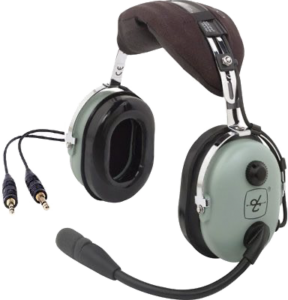By Martin Pauly ✈ October 31, 2020

Most pilots have a flight bag with compartments for things like headsets, a flash light, and an iPad. iPads have all but replaced printed charts (maps) in the cockpit, and while printed paper charts may still be used, their electronic versions have some advantages.
Here are some examples of flight bags.

Now, what goes into the flight bag?
- A headset – the cockpit is loud, and to talk, to communicate over the radio, and to protect our hearing, we need to wear headsets. Depending on what you are looking for, they range in price from a couple of hundred to over a thousand Dollars. The higher-end ones will offer electronic noise cancelation, for especially good noise attenuation. Some models offer different connectors; the ones you want are called dual male plugs, fixed wing, or PJ-055 & PJ-068. Here are some examples of regular headsets and some with active noise reduction.
- A logbook – every pilot is required to log aeronautical experience required for a pilot certificate. Logbooks also have space for endorsements which your instructor will give for things like solo flight privileges or to recommend you for the practical test. Here is an example.
- A flashlight – when you fly at night, the airplane has lights to illuminate the flight instruments and to read charts and checklists. But in case of an electrical problem – and for the preflight inspection in the dark – you need to have a flashlight. I recommend a regular one and a second one you can wear on a headband, to keep your hands free. Some examples here.
- A kneeboard, like this one – useful to hold your flight planning materials and to write down notes during the flight.
Charts, iPad, and iPad Apps

For paper charts, you want to have two so-called sectional charts available. For students based in eastern Iowa, you should get the Chicago and Omaha charts. You can buy them from multiple companies, such as this one.
If you want to display electronic charts instead, you can do that on an iPad. I prefer the mini size, since the larger models are simply too bulky and tend to get in the way. Multiple apps are available, some free of charge like FltPlan Go, and others that require a paid subscription for the chart and data updates, such as ForeFlight Mobile.
